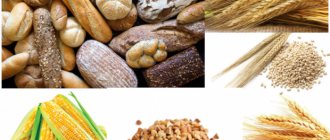Cottage cheese is rightfully recognized as one of the most healthy dairy products, because in addition to its excellent taste, it contains microelements such as calcium, phosphorus, folic acid, vitamin B2 and kefir grains. It affects the formation of the baby’s bones and teeth, has a beneficial effect on internal organs (heart, liver), the state of the nervous system, and also improves metabolism in the body. Therefore, it is introduced into the complementary feeding of babies among the first products.
Beneficial features
This fermented milk product is a leader in calcium and phosphorus content, which are extremely important for a growing body, as they are involved in the formation of bone tissue. If parents want their baby to develop a strong skeleton and good baby teeth, then they should focus on cottage cheese.
The product also contains the following useful ingredients:
- substances that form the basis of a healthy diet: proteins, fats, carbohydrates;
- lactic acid bacteria have a beneficial effect on digestion;
- vitamins A, E, D, group B.
- minerals: calcium, phosphorus, magnesium, potassium, iron, zinc, chlorine, sodium, selenium.
All these beneficial substances have a beneficial effect on the children's body. The baby will not have enzyme deficiency, metabolism will improve, and the work of many internal organs will be properly organized.
Compound
The requirements for the composition of children's curds are quite strict. They are made exclusively from fermented milk products that have undergone heat treatment after ripening.
The basis of cottage cheese is whole natural or normalized milk. During the production process, its natural fat content is preserved; it must be at least 2.8%.
Cottage cheese helps replenish the lack of calcium and phosphorus in the baby’s body. They are needed for normal growth of bones and teeth. The child's body is quite good
digests curd products. The composition contains the following beneficial substances:
- easily digestible protein;
- vitamin A;
- protein albumin;
- lactobacilli;
- vitamin D
Easily digestible protein is an important amino acid that takes an active part in the formation of bone tissue and muscles. Vitamin A has a positive effect on a child's vision. The protein albumin helps strengthen the immune system.
It activates the production of antibodies. Lactobacilli are present in all fermented milk products. They normalize intestinal function. Cottage cheese is also useful for preventing the development of rickets, as it contains vitamin D.
The composition may contain food additives and fruit fillers. However, doctors do not recommend giving such products. It is better to give the baby pure cottage cheese, which will be without unnecessary additives.
Possible harm
This is a perishable product; E. coli quickly begins to multiply in it. If you eat it, it is fraught with the development of an intestinal infection. The permissible shelf life in the refrigerator after opening the package is 72 hours.
Cottage cheese is contraindicated if you have kidney disease or are intolerant to milk protein.
You should postpone introducing fermented milk products if a baby fed on breast milk quickly gains weight. It is also necessary to delay its inclusion in the diet; early overgrowth of the fontanelle has occurred, indicating an increased concentration of calcium in the body.
At what age can complementary foods be introduced?
Feeding a baby cottage cheese until six months is strictly prohibited. The product contains a lot of protein (6 times more than milk), which leads to increased kidney function in children under 6 months.
Other undesirable consequences are also possible: the development of arterial hypertension, diabetes mellitus. So, from how many months can you give cottage cheese to your baby? If before the introduction of complementary foods the baby was bottle-fed, the product should be included in the diet at 6-7 months. If the baby was fed only breast milk, the introduction of cottage cheese should be postponed for 4-8 weeks.
This rule does not apply to children with rickets and severe underweight. In such cases, you can give cottage cheese earlier, but only with the doctor’s permission. The famous pediatrician Komarovsky has his own opinion on this matter. He recommends introducing the product at 6 months with the addition of kefir. These products are most closely related to milk and artificial formulas, so there will be no problems with digestion of food.
When can I enter
The timing of introducing cottage cheese into complementary foods depends on what kind of feeding the child is on. For breastfed babies, it can be started at 8-9 months, for bottle-fed babies - at 7 months. But provided that the baby has already become acquainted with vegetables, fruits, and cereals.
It is contraindicated to administer this product to an infant before six months of age. This is due to the work of the pancreas, which begins to fully produce enzymes for the proper digestion of this product only from 6 months.
When should you feed your baby cottage cheese?
At what age can you give your baby cottage cheese? It depends on the type of feeding the baby is fed. It is recommended that bottle-fed babies be introduced to complementary foods from seven months, and breastfed babies from 8-9 months.
The age difference is explained by the lack/excess of nutrients entering the baby’s body. Breastfeeding provides the baby with the necessary nutrients, which cannot be said about artificial feeding. In practice, complementary foods made from cottage cheese are given to six-month-old children who have tried porridge and fruit and vegetable purees.
However, it is not advisable to introduce cottage cheese without the recommendation of a pediatrician: not every small organism can cope with concentrated animal protein. Before making the first complementary feeding with cottage cheese, notify your local pediatrician.
When is it better to give complementary foods in the form of cottage cheese to a child?
Like any new complementary food, cottage cheese can be introduced into the diet in the morning, when the baby is not sick and is in a cheerful mood. It is forbidden to give complementary foods three days before and after a scheduled vaccination, when the baby is sick or has just recovered from an illness.
It is also prohibited to introduce complementary foods:
- for allergies;
- if the child’s fontanel does not heal on time.
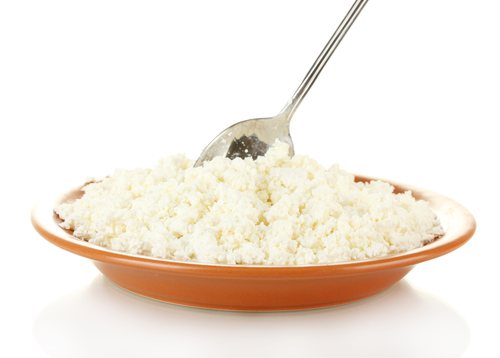
Why can’t you give cottage cheese before the specified time? Because an excess of protein can adversely affect the metabolic processes of a small organism, and the baby must first become familiar with other types of complementary foods - cereals, vegetable and fruit purees.
Some babies are prescribed curd complementary foods at the age of 12-14 months, and even then, not every day. If you are allergic to dairy products, you should not indulge in cottage cheese - consult your doctor.
How to properly introduce complementary foods
Despite the fact that cottage cheese is considered a healthy product, it is a heavy food for a child’s undeveloped digestive system. Therefore, it should be administered following all the necessary timing and dosage.
The introduction of cottage cheese into complementary foods begins when the baby is absolutely healthy. If your baby has been vaccinated or is about to receive one in the near future, then the introduction of the product should be postponed for a week.
If there are no obstacles, then you need to start introducing a new product in small doses - with one teaspoon. After that, watch the child for a day. If no changes have occurred in the body, you can continue introducing cottage cheese complementary foods. Gradually, the volume of the product, depending on age, increases to the daily norm (7 months - 30 g, 8 months - 40 g, 9-12 months - 50 g).

Scheme for introducing cottage cheese:
- 1 day - 5 g (1 tsp);
- Day 2 - 10 g (2 tsp);
- Day 3 - 15 g (3 tsp);
- Day 4 - 20 g (4 tsp);
- Day 5 - 30 g (6 tsp);
- Day 6 - 40 g (8 tsp);
- Day 7 - 50 g (10 tsp).
Some feeding rules:
- to improve the taste of the product, you can add food that is already familiar to the baby (this can be fruit or vegetable puree);
- if the baby refuses the cottage cheese, there is no need to insist, you can try again in a couple of days;
- During the first few months, cottage cheese is given 1-2 times a week.
At what age should you start introducing a child into the menu?
This depends on the type of feeding of the baby - whether it is fed with mother's milk or is artificial. If during breastfeeding it is introduced into the diet from 8-9 months, then during artificial feeding - from 6 months.
Sour milk should be introduced into the diet after the baby has already become acquainted with juices, vegetables, porridge without milk, fruits and meat. If the baby has a severe calcium deficiency (rickets), then the sequence of introducing new calcium into the diet can be changed, but not radically.
What kind of cottage cheese should I give to children?
Currently, stores sell ready-made curds for infants. All of them are produced taking into account the age of the little gourmet and are safe for the developing digestive system. In addition, store-bought curds have a soft texture and a pleasant taste; children eat such a delicacy with great pleasure.
When choosing such a product, it is important to consider the following:
- should be called “children’s cottage cheese” or “cottage cheese”;
- it must have a minimum shelf life;
- When purchasing, be sure to check the production date (48 hours);
- must not contain any additives.
Despite the advantages of store-bought cottage cheese, many mothers prefer homemade cottage cheese, prepared on their own. However, pediatricians do not recommend giving this product to children under 3 years of age. Specialized children's cottage cheese is produced to strict quality standards that are difficult to meet at home.
How is the product useful?
A baby's diet up to one year of age mainly consists of mother's milk or formula. Cottage cheese contains many useful substances that stimulate the liver, strengthen the heart muscle and normalize metabolism. In addition, this food has the following beneficial properties:
- It is rich in proteins, carbohydrates and fats.
- It contains calcium and phosphorus, which are needed not only for the formation of strong teeth and bones. The elements will prevent the development of rickets and other abnormalities in the development of the spine, parietal and frontal tubercles of the skull and leg bones.
- An infant receives albumin protein from cottage cheese, which is important for the synthesis of antibodies and strong immunity.
- Each type of fermented milk product has optimal acidity. Once in the body, it has a beneficial effect on the microflora of the intestines and stomach and promotes the absorption of food.
Curds, like other foods, have some contraindications. They are not included in the diet in case of individual intolerance to milk protein and kidney disease. It is forbidden to eat fermented milk if the baby is overweight or has poor fontanelle healing. In all other cases, cottage cheese can be eaten without special restrictions.
How to make at home
Making cottage cheese yourself is very simple, using a minimum of ingredients. Let's look at a few recipes:
- Recipe one: Pour 200 ml of kefir into an enamel pan, put it on the stove, reduce the temperature or heat to low. When the mixture has curdled, transfer it to a sieve to drain excess liquid. Then rub through a sieve with a spoon. The product is ready to use.
- Recipe two: Pour 200 ml of kefir into an enamel pan, place it on the stove and bring to a boil. Then cool the boiled milk to room temperature and add 2 ml of calcium chloride (purchased at the pharmacy). Mix well, put on the stove and bring to a boil. The milk will curdle. Transfer it to a sieve to drain the liquid. Rub the resulting mass through a sieve with a spoon.
- Recipe three: Place kefir in the freezer overnight. In the morning, take it out, remove the plastic wrap, and put it in a sieve. After 3-4 hours, the frozen kefir will melt, the liquid will drain and a soft curd mass will remain, ready for use.
How to make cottage cheese at home
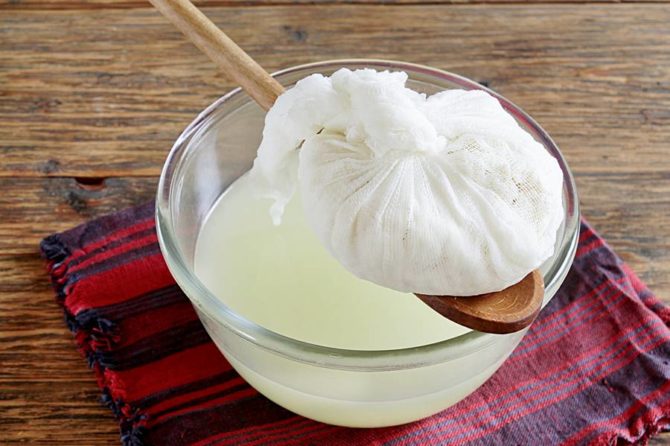
Curd recipes for babies are based on the separation of whey as a result of milk coagulation. When heated, kefir (or milk with potassium) separates the liquid, and the rest forms a curd curd.
The use of milk in home recipes is preferable, since the product is the main ingredient in curd production technology. But the sensitivity of the child’s body to casein does not allow us to recommend cottage cheese with milk.
Cottage cheese recipes
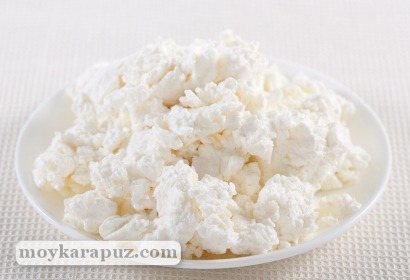
From the age of 12 months, a child can start cooking and giving some dishes made from cottage cheese. Let's look at what you can cook for your baby.
Cottage cheese casserole with apple
Ingredients:
- cottage cheese - 75 gr;
- apple - 1 piece;
- sugar - 1 tsp;
- egg - 1 pc.
Preparation:
Wash the apple thoroughly under running water, peel it and grate it on a fine grater. Rub the cottage cheese through a sieve, add the egg, sugar, grated apple and mix. Grease a baking dish with butter, pour in the mixture and distribute evenly. Place in a preheated oven. Bake at 180°C for 30 minutes.
Lazy dumplings with cottage cheese
Ingredients:
- cottage cheese - 200 gr;
- egg - 1 piece;
- flour - 4 tbsp. l.;
- salt to taste;
- butter.
Preparation:
Mix the cottage cheese with the egg and puree through a blender. Add flour, salt and knead the dough. Roll it into a sausage and cut into small pieces. Place water on the stove, bring to a boil, add salt. Carefully place the pieces of dough into the water and cook until they float (usually 2-3 minutes). Remove the dumplings with a slotted spoon, place in a bowl and add a knob of butter. Before eating, you can add sour cream to lazy dumplings.
Cottage cheese should become an integral part of a small child’s diet, of course, if there are no contraindications. But there is no need to rush to introduce it into complementary foods, everything should be done in a timely manner.
Views:
8288.
Some recipes for making cottage cheese at home
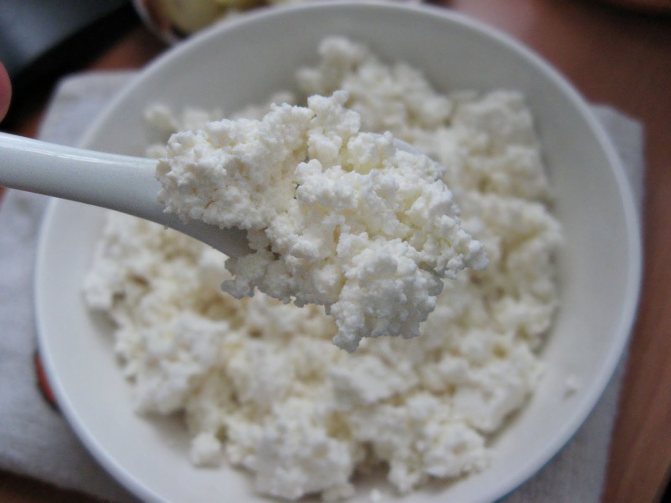
A special cheese for baby food is ideal for your baby. It is already peeled and fat-free. But if you want to pamper your little one with something homemade, here are a few homemade cottage cheese recipes:
- Kefir curd. Kefir has a beneficial effect on the digestive system, saturates the intestines with beneficial bacteria and has antiseptic properties. It is fashionable to give baby kefir on days when the baby has indigestion or an upset stomach. Pour kefir into a saucepan and put on fire. It is necessary that the mass heats up well, but does not boil. As soon as it is about to boil, set the saucepan aside and let it cool. After this, strain the cottage cheese through cheesecloth and place it under a press to remove excess liquid.
- Cottage cheese made with milk and calcium chloride. Calcined dairy products are beneficial for children at any age. To prepare a calcium-enriched treat, place a saucepan on the fire and pour in the milk. Wait until it boils and add 2-3 tablespoons of calcium chloride. If the cottage cheese does not “make” well, then add another spoonful of calcium.
Despite all the prejudices and different opinions about when to introduce cottage cheese into a baby’s diet, such a product will definitely have a beneficial effect on the development of the child’s body as a whole.
Which cottage cheese is better
Cottage cheese for babies varies in fat content:
- Dairy contains 5% fat, it is recommended for sedentary large children who move little and quickly gain weight.
- A creamy product with a fat content of ten to 15% is indicated for hyperactive infants and those who have difficulty gaining weight.
- All children can be given combined cottage cheese, which contains fats of vegetable and animal origin. The option, with a fat content of 6%, is optimal in composition, enriched with substances necessary for the growth and development of babies.
If we talk about a homemade product, there are 2 types of cottage cheese according to the method of preparation:
- Fresh, or calcified, ideal for breastfed babies and those who are not gaining weight well.
- Kefir or sour curd, which is prepared from baby or regular kefir.
What kind of cottage cheese should I give to infants who are developmentally delayed or are not gaining weight well? In this case, options with various fruit, vegetable and fruit and berry fillings are preferable. If you decide to give your child cottage cheese with black currants, bananas, raspberries, carrots and other additives, make sure that all its ingredients are natural.

